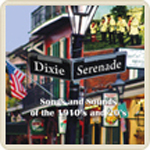DIXIE
SERENADE Dopo circa un secolo, i suoni e l’atmosfera di queste formazioni “povere” rivivono anche in Italia con questo disco di “Dixie Serenade”, intitolato “Songs and Sounds of the 1910’s and 20’s”. “Dixie Serenade” è un gruppo fondato da alcuni musicisti milanesi, non più giovani, che alla fine degli anni ’40, ancora adolescenti, conobbero e si appassionarono al jazz di New Orleans di cui i primi dischi a 78 giri avevano iniziato a circolare liberamente anche in Italia. Al gruppo originario si è aggiunto successivamente Maurizio Signorino, un più giovane e quotato saxofonista jazz che ha apportato un pizzico di “moderno” pur senza stravolgere il sound originale della formazione che continua ad ispirarsi alle “washboard bands” di un centinaio di anni fa. Il repertorio di “Dixie Serenade” è costituito principalmente da brani di jazz tradizionale (dixieland) e da canzoni popolari in voga nei primi decenni del ventesimo secolo in America. I nove brani di questo disco sono infatti di questo periodo (da “Bill Bailey” del 1902 a “When You’re Smiling” del 1928). Nelle esibizioni “live”, tuttavia, il gruppo esegue anche numerosi pezzi di jazz e canzoni (americane e non) composte nei decenni successivi (anni ’30, ‘40, ecc) ma sempre eseguite nelllo stile proprio delle “washboard bands” americane del primo ‘900. “Dixie Serenade” si esibisce in eventi pubblici o privati e di preferenza a stretto contatto con il pubblico in strade e piazze, in parchi e in luoghi di ritrovo sia all’aperto che al coperto (ristoranti, circoli sportivi, ecc.) con esecuzioni sterttamente “live” e senza eccessive amplificazioni. In caso di concerti o di feste danzanti, la formazione può venire rinforzata con l’aggiunta di qualche strumento (spesso un pianoforte) e in questi casi si avvale della collaborazione di validi musicisti jazz scelti fra i numerosi amici di “Dixie Serenade”. * * * * * * * * * * * * * * * * In the early decades of the twentieth century, “Skiffle Bands”, “Jug Bands” or “Washboard bands”, playing blues, jazz and popular music were very common across the American Southern States. The rhythm section of these small combos used instruments made from common household objects of the era including jugs, spoons, washboards, wash tubs, comb-and-paper kazoos, etc. plus a banjo or a guitar. The melody was generally performed by a couple of traditional European instruments like a clarinet, a trumpet or a violin. Nearly a century later, the sounds and the mood of these “poor” formed old time bands are now being relived and introduced once again by the Italian washboard band “Dixie Serenade” on their first record: “Songs and Sounds of the 1910’s and 20’s”. “Dixie Serenade” band originated in Milan and was formed by a group of senior musicians who began listening to New Orleans Jazz in the late 40’s when American jazz records started to be made available freely circulated even in Italy. More recently, the band welcomes it’s newest and younger member, Maurizio Signorino, tenor saxophonist. Maurizio’s gifted talents will enhance the sound of the band by blending a touch of “modern jazz” and yet remaining loyal to the original sound of the “Skiffle Bands” of the first decades of the 1900’s. Dixie Serenade’s repertoire is mainly constituted by traditional jazz (Dixieland) and popular songs in vogue during the first three decades of the twentieth century. The nine tracks of this CD date back to that period indeed (from 1902’s “Bill Bailey” to 1928’s “When You’re Smiling”). Nonetheless in their live performances, “Dixie Serenade” also play several jazz standards and songs composed during the following decades (1930’s, 40’s, ect.), always performed in the distinguished style of the American “washboard bands” of the very early 1900’s. “Dixie Serenade” plays at private and public events, enjoying close contact with the audience in squares, streets, parks as well as outdoor and indoor venues (restaurants, sporting clubs, etc.) performing purely “live” and avoiding excessive sound boosting. On occasion of concerts or dancing parties, the addition of one or two instruments (often a piano) may be required. In these events the appropriate guests (all valid jazz musicians) are then chosen amongst the numerous friends of “ Dixie Serenade”.
Un breve accenno ... del nuovo CD ... "buon ascolto"
|
 |


